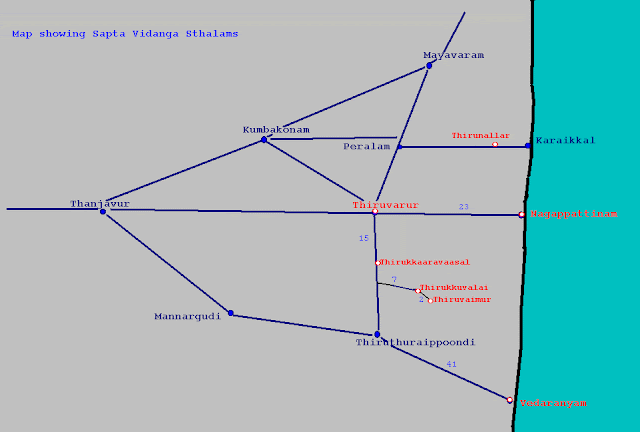In the Vidanga temples there will be a Thyagarajar moorthi. It is the Saha Umaa Skandha (generally called Soomaaskandha) form of Lord Shiva. The Thyagarajar moorthi came out of the inhale(uchisvasam) and exhale(nichisvasam) of Maha Vishnu performing Ajaba Nadanam. Initially this moorthi was worshipped by Maha Vishnu, and he got a beautiful son Manmadha. Later he gave it to Brahma and he gave it to Indra. Indra worshipped the moorthi for a long time.
Muchukunda Chakravarthi, who had the face of monkey, was a great and valorous Chola king. He was once approached by Indra for help during the war between Devas and Asuras. Muchukunda gladly agreed to help the lord of the Devas, and joined in the war. Finally, with Muchukunda’s aid, the Devas succeeded in routing the Asuras, and Indra was extremely grateful to the king. He offered the king a gift of his choice, and Muchukunda, a devout man, asked for the Thyagarajar moorthi worshipped by Indra. Indra was stunned. He did not want to part with his precious moorthi, but the king wouldn’t accept anything else. He finally decided on a deception, so he ordered to make six similar moorthis and asked Muchukunda to find out the one he wanted. Muchukunda was a smart king, and prayed to Shiva to identify the correct one and found the original moorthi. So Indra gave him all the seven moorthis to Muchukunda. Muchukunda kept those moorthis in seven temples which are called Saptha (seven) Vidanga temples. (All these temples are in Tamil Nadu and situated around Thanjavur.)
Muchukunda returned to earth with the seven Thyagarajar moorthis and installed them at various places in his kingdom. The original one he kept at the temple at Thiruvarur, and the others at Thirunallar, Vedaranyam, Thiruvaimur, Thrirukaravasal, Thirukkuvalai and Nagapattinam. These seven temples are collectively known as Saptha Vidanga Sthalams. Vidanga means something that has not been chiseled out. These seven Thyagarajar moorthi are believed to be divine – not made by chisels.
Normally, Soomaaskandhar form of Shiva will come out of the temple during utsavams (festivals). But since the Thyagarajar is the pradana (main) moorthi in these temples, he will not go out during festivals. So the Chandrasekara form of Shiva will go out on utsavams. This Thyagarajar moorthi will not have abhishegam on all days. So, the Shivaperuman himself gave a part of his crescent moon in shape of lingams for performing the nithya (daily) poojas for Thyagarajar as his representative.
Usually, it is the top portion of the lingam – the ellipse which is believed to be swayambhu. The base – avudayar- is made by hand. In all these seven lingams, the whole lingam – the base as well as the top portion – form a single piece, and are believed to have appeared just the same way, without being made. All the seven lingams are of different sizes, though they are made of the same material – maragatham – or emerald. However, it looks more like Jade than emerald, as it is translucent. The biggest one is at Thirunallar, while the one at Thiruvarur is of medium size.
Indra is still believed to perform the Sayaraksha (Evening) pooja in Thiruvarur. And hence it is very special to attend this pooja in Thiruvarur even today.
The details of the Saptha Vidanga Sthalams:
Place
|
Name of Thayagaraja
|
Nadanam/Dance (நடனம்)
| |
1
|
Thiruvarur
|
Veedhi Vidangar (வீதி விடங்கர்)
|
Ajaba Nadanam (அஜபா நடனம்)
|
2
|
Thirukolili
|
Avani Vidangar (அவனி விடங்கர்)
|
Vandu or Brahma Nadanam (வண்டு/பிரம நடனம்)
|
3
|
Thiruvaymur
|
Neela Vidangar (நீல விடங்கர்)
|
Kamala Nadanam (கமல நடனம்)
|
4
|
Thirukarayil
|
Aadhi Vidangar (ஆதி விடங்கர்)
|
Kozhi Nadanam (கோழி நடனம்)
|
5
|
Thirumaraikkadu
|
Bhuvani Vidangar (புவனி விடங்கர்)
|
Hamsavagha Nadanam (ஹம்சவாக நடனம்)
|
6
|
Thirunallar
|
Naga Vidangar (நக விடங்கர்)
|
Unmatha Nadanam (உன்மத்த நடனம்)
|
7
|
Nagaikkaronam
|
Sundhara Vidangar (சுந்தர விடங்கர்)
|
Paaravaara Nadanam (பாரவார நடனம்)
|



No comments:
Post a Comment